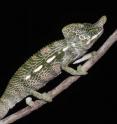Unheard of life history for a vertebrate
There is a newly discovered life history among the 28,300 species of known tetrapods, or four-legged animals with backbones. A chameleon from arid southwestern Madagascar spends up to three-quarters of its life in an egg. Even more unusual, life after hatching is a mere 4 to 5 months. No other known four-legged animal has such a rapid growth rate and such a short life span. The new research is reported in the current issue of Proceedings of the National Academy of Sciences. "It really is a huge surprise," says Christopher Raxworthy, Associate Curator in the Department of Herpetology at the American Museum of Natural History. "Adding to that, until now, the short life span of chameleons in captivity has always been considered as a failure to thrive. We need to rethink this."
Most mammals, reptiles, birds, and amphibians (all tetrapods) typically live 2 to 10 years, an average bracketed at the upper end by some long-lived animals (for example, turtles and humans that can live for a century) and at the lower end by a handful of animals that only live for about a year. The males in nine species of marsupials die off after a year, for example, as do most adults in about twelve species of lizards. But the chameleon described here, Furcifer labordi, not only has a brief, yearly life cycle, but the bulk of that time is spent incubating inside an egg. Once outside of the egg, all individuals in the population die within 4 to 5 months.
Kristopher Karsten, a graduate student from the Department of Zoology at Oklahoma State University, discovered the unusual life cycle almost by accident. "I showed up late in the season and found something weird," recalls Karsten. "There were no juveniles. But by February, I found carcasses all over with no signs of mutilation or predation. The population plummeted—we've never seen this with other lizards."
Now, after five seasons of data and sightings of nearly 400 individuals, the life cycle of F. labordi can be described. Hatching begins with the rains in November, and, once emerged, the chameleons develop rapidly, growing up to 2.6 mm (0.1 inches) a day—up to two orders of magnitude greater than other known lizard growth rate. In less than 60 days, for example, there can be a 300%-400% increase in body size for males to reach adulthood. After reaching maturity, the population reproduces, and females burrow through about 138 mm (5.4 inches) of sand to lay their eggs. Once covered, the eggs wait out the dry season for the next 8 to 9 months, and all adults die.
"It is amazing to think that for most of the year, this chameleon species is represented only by developing eggs buried in the ground," says Raxworthy. "This species really illustrates just how much there is still to discover about the natural history of Madagascar." Karsten agrees, adding: "We've identified a species that does something really different from the others, but what is driving this system? One bad year could wipe out these chameleons."
Source: American Museum of Natural History
Other sources
- Observatory: From a Chameleon With a Short Life, Aging Insights?from NY Times ScienceFri, 4 Jul 2008, 4:35:27 UTC
- Malagasy chameleon has unusual life cyclefrom UPIThu, 3 Jul 2008, 15:14:43 UTC
- Malagasy Chameleon Spends Most Of Its Short Life In An Eggfrom Science DailyTue, 1 Jul 2008, 21:35:16 UTC
- Creature Sets Record for Living Fast, Dying Youngfrom Live ScienceMon, 30 Jun 2008, 21:07:26 UTC
